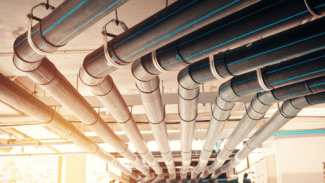These apartments will soon get their heat from wastewater
Two new high-rises in the Bronx are installing a system called SHARC that captures wastewater for heating and cooling.
At two high-rise apartment buildings in the Bronx, when a tenant takes a shower or does laundry, the hot water that goes down the drain will soon help heat their apartment in the winter—or cool it in the summer.

As water is heated up, “it’s just this tremendous energy source,” says Lynn Mueller, CEO of Vancouver-based SHARC Energy Systems, the company that makes the wastewater heat recovery system that the apartments plan to use. The Department of Energy estimates that 350 billion kilowatt-hours of energy flow into U.S. sewers in the form of heat each year. With SHARC’s technology, that energy can be reused. “The energy never leaves the building,” Mueller says.
The company installs large tanks—up to 14 feet deep and 8 feet wide—in a building’s basement, where wastewater flows and is cleaned to go through a heat exchanger, which captures the energy for use in the building’s heating/cooling system, or to reheat water. After the heat is captured, the wastewater keeps flowing into the sewer. (Financially, it makes sense to install the system in larger buildings, rather than single-family homes, Mueller says.)
In mild climates, the heat going down the drain can be enough to handle the building’s heating, cooling, and hot water needs on its own. That’s the case in one large new development in Vancouver, and at a new 250-acre research hub in Denver, both of which are using SHARC’s tech. In a place with colder winters, the system works along with geothermal technology that accesses the steady temperature underground by drilling holes.
Using both technologies together cuts the cost of installing geothermal. “It reduces the number of geothermal boreholes by 40% or more, and that can reduce the cost of putting in a geothermal system by sometimes millions of dollars,” says Jay Egg, president of Egg Geothermal, one of the partners leading the project. In a city like New York, it can also make geothermal feasible; the technology otherwise takes up so much space that it often can’t fit on limited urban land.
Under a New York City law, large buildings are required to cut emissions 40% by 2030 or pay fines. Buildings are, by far, the biggest source of the city’s climate pollution. The Amalgamated Housing co-op won a state grant to explore the use of the two combined technologies, and another state grant may help fund it, though the co-op plans to proceed whether or not that funding comes through. The existing system is at the end of its useful life and needs to be replaced. “Our goal is to do this with no cost to [residents],” says Ed Yaker, Amalgamated’s treasurer. It’s possible that the new system will reduce the monthly fees that residents pay the co-op for utilities.
As new climate laws are passed, Mueller says that SHARC, which was founded more than a decade ago, is now seeing sharply increased demand. More projects are being planned in New York City. Mueller, who says that other cities, including Vancouver, are phasing out natural gas in buildings, muses, “I think the shift is really underway.”
Source: Fortune















 Accessibility
Accessibility